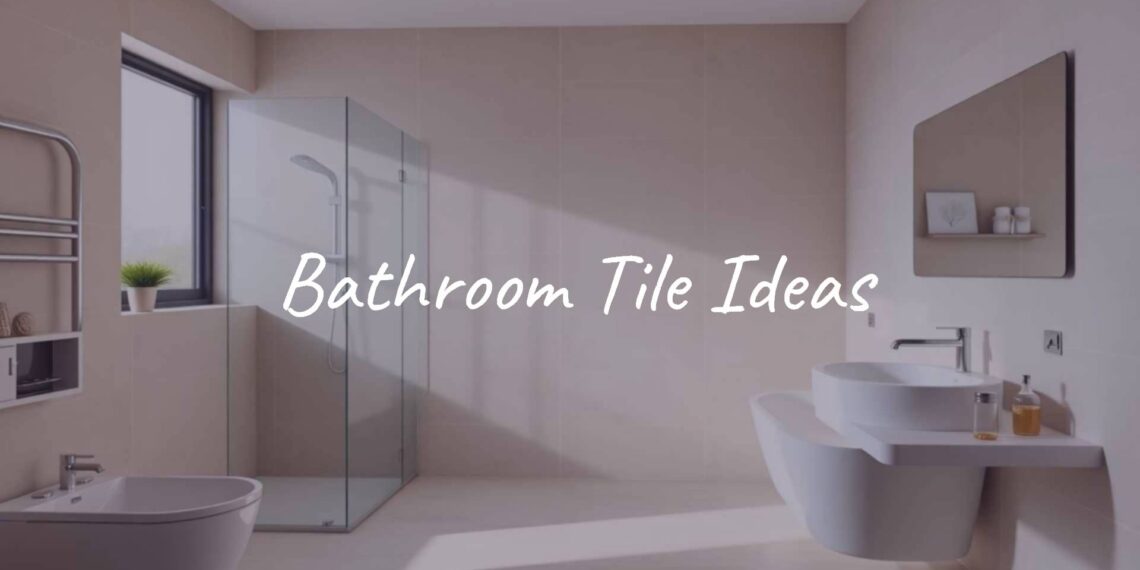Choosing the right tiles is one of the most important decisions you’ll make when updating your bathroom. Tiles do more than just cover surfaces; they set the tone, affect the atmosphere, and can even change how big the space feels. Whether you want your bathroom to feel like a peaceful spa, a fun, bold retreat, or a clean, modern space, there are many bathroom tile options to explore. You can pick from various materials, finishes, colors, and patterns, with each detail helping to shape the look and feel of your bathroom. This guide will walk you through many of these choices, so you can pick the best tiles to make your bathroom both beautiful and practical for years ahead.
What Are the Best Bathroom Tile Ideas for Every Style?
The best tile idea for a bathroom depends on your personal taste, your home’s style, and what your bathroom needs in terms of function and looks. Still, some types, finishes, and colors work well for various styles. It’s important to think about how each choice will work together to create the look you want.
For example, if your home has strong architectural details, your tiles can match that style. An older Spanish-style house might look great with vintage tiles, while a more basic or modern space could let a bold tile floor stand out. In the end, the best tiles are the ones you enjoy, that do their job well, and make you happy every day.
Should You Choose Ceramic, Porcelain, Stone, or Glass Tiles?
Tile materials usually come down to ceramic, porcelain, stone, or glass. Each has its own look, strength, and care needs:
- Ceramic: Common and affordable, with lots of color and pattern options. Durable and easy to clean-good for most bathroom uses.
- Porcelain: A type of ceramic that’s harder, denser, and more waterproof. Great for high-traffic areas and shower floors.
- Stone: Such as marble, slate, and travertine. Offers rich, unique patterns and luxury, but usually needs more care and sealing to prevent stains.
- Glass: Shiny, light-reflecting, and modern-often used for accents or in wet areas for their bright look and moisture resistance.

How Do Tile Finishes Affect Bathroom Design?
Tile finish-how the surface looks and feels-matters a lot in your bathroom:
- Glossy: Found in ceramic and glass tiles. Reflects light, brightens a room, and is simple to wipe clean. Can be slippery, so caution on floors.
- Matte: Subtle and elegant, with better grip-ideal for floors and hiding dirt or smudges.
- Textured: Such as zellige or terra-cotta. Adds tactile appeal and is popular for creating depth.
- Honed (mainly in stone): Smooth but not shiny, adding a soft, sophisticated touch.
What Are the Most Popular Tile Colors for Bathrooms?
Trends keep changing, but some tile colors are always popular because of their effect on a room’s size and mood:
- White: Clean and bright, makes spaces look bigger and matches nearly everything.
- Neutrals (gray, taupe): Calm, timeless, and versatile for any design.
- Green: From deep emerald to gentle sage, trending for a nature-inspired boost.
- Blue: Ranges from pale aqua for relaxation to rich navy for drama.
- Warm browns and ochre: Cozy, inviting, and increasingly popular.
- Bold colors: Used as accents for those who want a bit more personality.
Pros and Cons of Different Bathroom Tile Materials
Knowing the strengths and weaknesses of each tile type helps you choose the best one for your needs and budget. Here’s a quick comparison:
| Material | Main Benefits | Main Drawbacks |
|---|---|---|
| Ceramic | Affordable, easy to clean, lots of designs | Less water-resistant than porcelain, can chip |
| Porcelain | Very durable, highly water-resistant, low-maintenance | Can cost more than ceramic, heavier, harder to cut/install |
| Natural Stone | Unique look, luxurious, variety of options | Needs sealing, stains easily, higher price |
| Glass | Reflects light, modern, water-resistant, easy to clean | Can show streaks, may chip easily if not installed carefully |
Porcelain vs. Ceramic: Which Is Better for Wet Areas?
Porcelain is usually best for wet spots (like showers and floors) because it’s dense and absorbs less water. Ceramic is good for less wet places like walls because it’s easier on your budget but isn’t as water-resistant.
Stone Tiles: Natural Beauty and Maintenance Needs
Stone tiles (marble, travertine, slate) offer a one-of-a-kind look. They are long-lasting but need sealing and gentle cleaning to avoid stains and damage.
Glass Tiles: Reflectivity and Cleaning Considerations
Glass tiles are bright and modern, usually not stained by water but can show water spots. They can chip if mishandled during installation, so it’s safest to have a professional install them.
Are Mosaic Tiles Durable in Bathrooms?
Mosaic tiles are small and have lots of grout lines, which helps prevent slipping-great for shower floors. If installed and maintained well, mosaics are sturdy and can be customized in endless ways for patterns or pops of color.
Trending Bathroom Tile Patterns and Layouts
The way you arrange your tiles can radically change how your bathroom looks. Here are some layouts and shapes that are popular right now:
Herringbone, Chevron, and Other Classic Patterns
- Herringbone: Creates a “V” shape for a striking, classic look that moves the eye around the space.
- Chevron: Like herringbone but with continuous zigzags.
- Straight lay: Simple and neat.
- Subway (brick) pattern: Timeless and works everywhere.
- Basketweave: Feels luxurious and detailed, often used for mosaic floors.

Mixing Tile Shapes: Hexagons, Penny Rounds, and Scallops
- Hexagon tiles: Add interest and can go on either floors or walls for a modern touch.
- Penny rounds: Retro and fun, especially fitting for shower floors due to their slip-resistance.
- Scallops (“fish scale”): Whimsical and elegant, best for feature walls or partway up a wall.
Geometric and Graphic Tile Designs
Geometric tiles (bold shapes, repeated patterns, even high-contrast designs) are ideal for making a statement. Mixing graphic tiles with vintage pieces or old furniture can give a space extra personality.
Does Tile Direction Affect the Perception of Space?
The way you lay your tiles-horizontally, vertically, or in patterns like herringbone-can make the room appear wider, taller, or more open. Laying large tiles the same direction as the floor or up the wall can create the sense of more space.
New Ideas for Using Bathroom Tiles on Walls and Floors
Tiles aren’t just for covering basic areas-there are creative ways to use them as design features:
Feature Walls: Using Tile as an Accent
Covering just one wall with a dramatic tile lets you enjoy a bold look without using it everywhere. For example, choose a colorful or patterned tile behind the vanity for a strong focal point, and keep the other walls simple.
Framing Fixtures with Contrasting Tiles
Surrounding a showerhead, tub, or even a mirror with tiles in a different style or color helps highlight these areas and adds detail without too much extra work or expense.
Floor-to-Ceiling Tiling for a Spa-Like Effect
Covering every wall with tile creates a seamless, high-end appearance and makes cleanup easy. It also protects against water and stains, perfect for busy family bathrooms.

The Impact of Grout Color and Grout Pattern in Bathroom Tile Design
Grout isn’t just functional-it has a big effect on how your tiles look:
Should You Use Contrasting or Matching Grout?
- Matching Grout: Makes tiles blend together and gives a smooth, continuous look. Great for modern rooms or when tiles have bold patterns.
- Contrasting Grout: Highlights each tile’s shape and pattern, creating a grid or outline. Works well for classic subway tile or when you want the tile shape to stand out.
Does Grout Width Change the Look of Tiles?
- Wide lines: Give a rustic or old-style feel, draw more attention to the grout.
- Narrow lines: Make tiles look larger and cleaner, good for modern designs and large-format tiles.

Bathroom Tile Ideas for Small, Large, and Awkward Spaces
Bathrooms come in all shapes and sizes, and your tile choices can help with everything from making a small bathroom feel bigger to breaking up a large space.
How to Make a Small Bathroom Appear Larger
- Use big tiles to reduce grout lines and create a smoother look.
- Light colors and shiny finishes reflect light and make the room feel open.
- Continue the same tile up the back wall or across the room for a more spacious effect.
- Use the same color in different patterns for interest without making the space feel busy.
Tiling Tips for Large and Open Bathrooms
- Change tile styles or colors to mark different areas like the tub, shower, or vanity.
- Try bold patterns or larger slabs for a dramatic statement (for example, covering a whole wall in marble tiles).
- Mix rich colors and patterns without worrying about overwhelming the space.
Creative Tiling for Niches and Bathtub Surrounds
Small spaces like shower shelves or around the tub are great for using bold tile choices or patterns. You can use colorful mosaic tiles in a niche or wrap the walls around your tub in bright or shiny tile for extra impact and easy cleaning.
Can Tiles Add Warmth and Texture to Windowless Bathrooms?
Yes. Wood-look tiles, textured finishes, and warm earth tones can make a bathroom without windows feel much cozier. Textured tiles, whether glossy or matte, add depth and interest, and soft lighting alongside reflective tiles can make the room feel brighter and more welcoming.
Mixing and Matching Different Tile Styles
Combining different types, colors, and finishes of tiles can give your bathroom character. The key is to strike a balance so the design feels put together, not chaotic.
How to Pair Monochrome and Patterned Tiles
Using a solid-colored tile (like plain white) alongside a patterned or graphic tile helps ground the design. For instance, you might put plain tiles on the floor and a bolder patterned tile on a feature wall. Vice versa works too-keep the floor bold and walls neutral. Sticking to similar shades makes the design feel connected and not too busy.
Should You Blend Natural and Glossy Finishes?
Mixing natural matte tiles with glossy ones adds interest and helps each feature stand out. The trick is not to overdo one type-let each finish have its place so the room feels balanced and inviting.
Risks of Using Strong or Bright Tile Colors
Vivid tile colors can make your bathroom fun and lively, but using too much can make it feel busy or quickly go out of style. It’s safer to use bright tiles as accents or in areas you can change easily. Bring color samples to the store to test combinations you like before making a final decision.
Budget-Friendly vs Luxury Bathroom Tile Ideas
You don’t need to spend a fortune to get a great-looking bathroom. Modern tiles at all price levels mean you can find something that works for your wallet, and smart choices let you get a high-end look without paying premium prices.
Are Affordable Tiles Durable?
Plenty of budget tiles, especially ceramic and porcelain, are tough enough for bathrooms. Check the PEI rating-this tells you how well a tile resists wear. Many budget tiles last just as long as more expensive options if installed and looked after properly.
How to Make a Bathroom Look Expensive on a Budget
- Choose large, basic tiles for most surfaces and save special, pricier tiles for small accents like a shower niche or backsplash.
- Use tiles that imitate marble or wood at a lower price.
- Pick classic patterns like subway or herringbone to elevate simple tiles.
- Play with grout color for a customized look.
- Combine tiles with nice fixtures in nickel or brass for instant style.
Inspiration: Creative and Unique Bathroom Tile Ideas
If you want something different, here are a few ideas to try:
Vintage-Inspired Tiles for Retro Vibes
- Penny tiles for a classic look (especially in black and white or retro colors).
- Rosette or antique-looking tiles for a cottage or old-house feel.
- Try mixing styles within a warm color palette for a cozy, lived-in appearance.
Nature-Inspired Tiles: Pebble and Wood-Look Options
- Pebble tiles on the shower floor for a natural, spa-like effect and better grip.
- Terracotta and ivory combinations for an earthy, calm space.
- Porcelain tiles that look like wood, for a farmhouse or rustic vibe without water issues.
Dimensional and 3D Tiles in Modern Bathrooms
- 3D tiles with raised patterns add shadow and texture. They’re great for accent walls or minimal spaces where you want something memorable.
- Mix sculptural wall tiles with plain surroundings for a modern and interesting feel.
















![What to with Scrap Metal? [infographic]?](https://facts-homes.com/wp-content/uploads/2019/07/645413-POPYOV-391-120x86.jpg)





